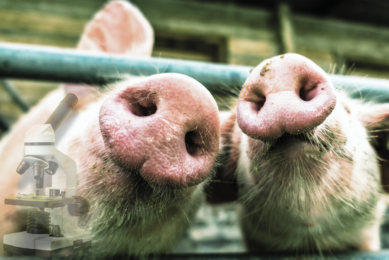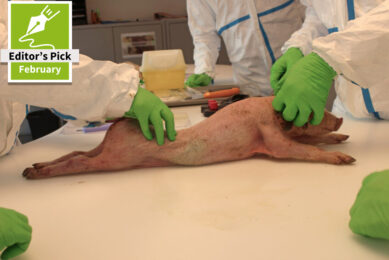Empowering poultry resilience for a sustainable future
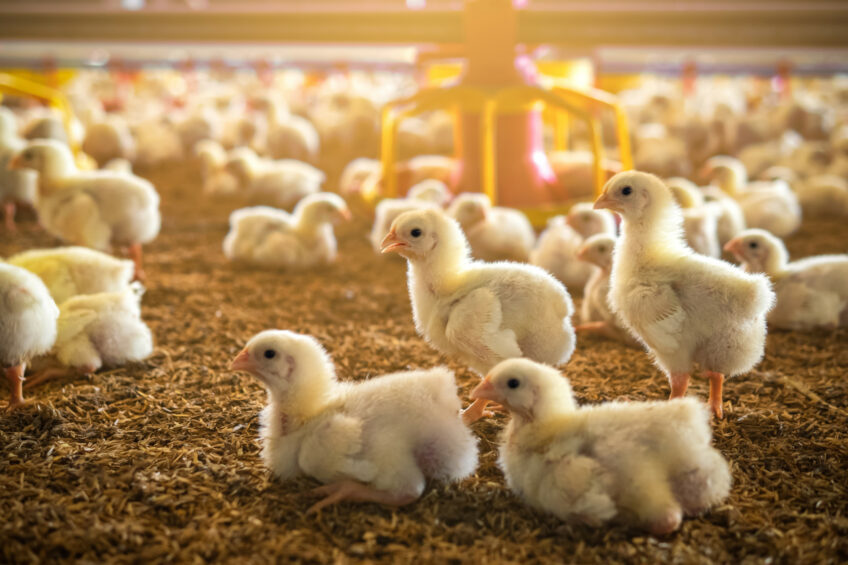
As the demand for high-quality and safe protein increases to meet the needs of a growing human population, so does consumer concern with animal welfare and the environmental impact of livestock production cycles. A premium yeast postbiotic may just offer the answer to meet these demands.
WORLD OF MICROBES SPECIAL 2024 – read all articles
In the poultry sector, meat demand is estimated to increase exponentially up to 181 million metric tons by 2050 (Figure 1). Increasing poultry production to convene this increasing demand will require improving feed efficiency and growth performance to avoid a concomitant exponential use of resources that would jeopardise production sustainability. Moreover, both abiotic and biotic stresses are likely to increase because of environmental changes. It is therefore important to address animal health and welfare using alternatives to antibiotics to improve animal resilience and avoid the development of antibiotic-resistant bacteria, which decrease the safety of poultry meat consumption. Phileo by Lesaffre offers an innovative solution Safmannan, a premium yeast postbiotic, designed to optimise poultry performance while improving food safety and the sustainability of the production cycle.
Figure 1 – Challenges in poultry sustainable production to meet consumer demands.
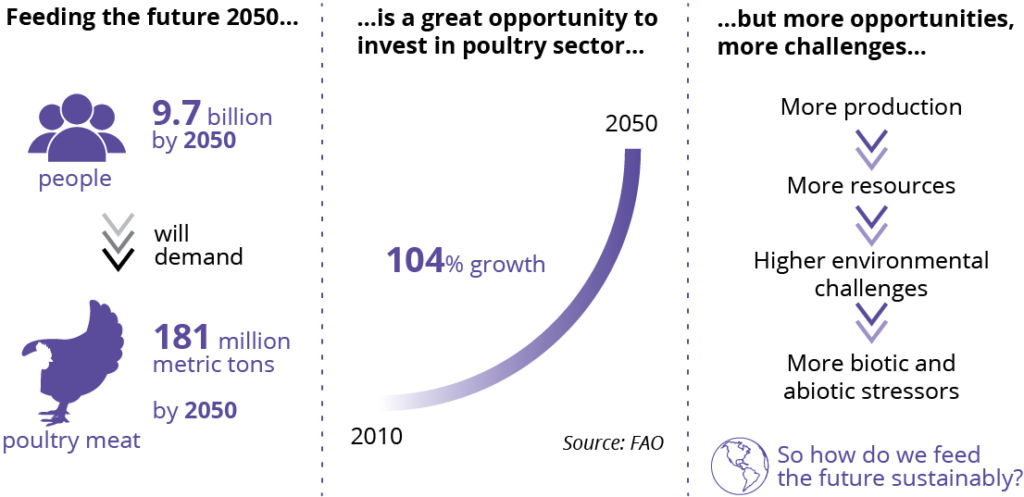
A new frontier in animal nutrition
Safmannan (hereafter called the reference postbiotic) is a high-quality yeast postbiotic derived from proprietary Saccharomyces cerevisiae. The rich (≥ 20%) contents in mannan-oligosaccharides (MOS) and β-glucans (1,3 and 1,6) of the reference postbiotic have demonstrated positive effects in the feed efficiency, growth performance, innate and acquired immunity, and stress resilience of broilers in both scientific and real-life trials. Postbiotics represent a new frontier in animal nutrition. Defined as “preparations of inanimate microorganisms and/or their components that confer health benefits on the host”, they offer similar benefits to probiotics but do not require live microorganisms, making them ideal for feed that undergoes high-temperature processing.
Scientifically proven modes of action
In studies conducted worldwide, the reference postbiotic-supplemented broilers always showed significantly enhanced FCR (-6% on average) and body weight (+4% on average) than control non-supplemented animals (Figure 2).
Figure 2 – Consistent positive effects of Safmannan in poultry performance.
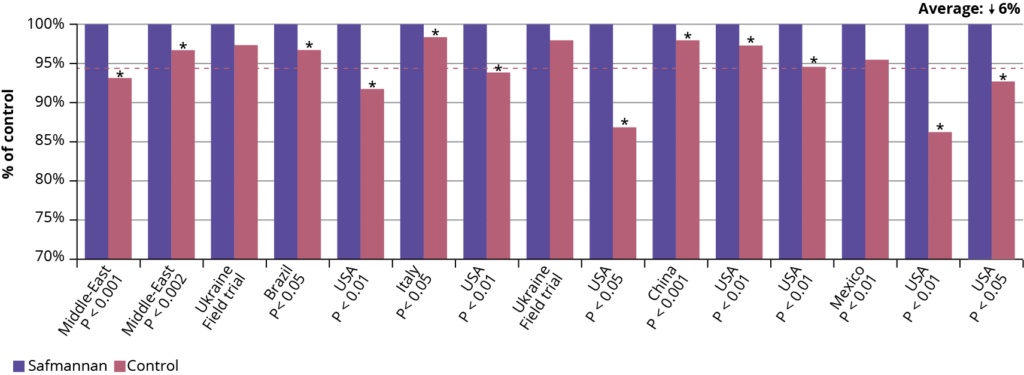
This performance boost is largely attributed to its positive effects on intestinal health. The reference postbiotic has been shown to increase villus/crypt ratio and expression of tight-junction proteins , which increase the surface available for nutrient absorption and reduce the risk of leaky gut, respectively. In addition, the reference postbiotic significantly contributes to goblet cell proliferation and mucin secretion, improving enterocytes’ protection.
The reference postbiotic high β-glucan content is a critical factor in its ability to modulate immune responses. β-glucans interact with dectin-1 receptors on immune cells, triggering the activation of macrophages and promoting antibody production. This enhanced immune response enables broilers to better resist viral and bacterial infections. For instance, broilers supplemented with the reference postbiotic demonstrated higher antibody titers against Newcastle disease, underscoring the postbiotic’s capacity to boost both innate and acquired immunity.
Moreover, the reference postbiotic promotes the proliferation of beneficial gut bacteria like Roseburia and Ruminococcus torques, which contribute to improved gut microbiota diversity and functionality. By reducing harmful Enterobacteriaceae, the postbiotic helps maintaining a healthy gut environment, reducing the risk of dysbiosis and associated diseases.
Managing biotic and abiotic stresses
One of the reference postbiotic standout features is its dual capability to manage biotic and abiotic stressors. Biotic stress, caused by pathogens like Salmonella and Clostridium perfringens, poses a significant threat to poultry health and performance. The MOS in the reference postbiotic bind type-1 fimbriae of Gram– bacteria (e.g., Salmonella sp. and Escherichia coli) and also binds Gram+ bacteria (e.g., Clostridium perfringens, inhibiting their growth and the proliferation of diseases such as necrotic enteritis. The reference postbiotic also significantly decreased Salmonella Heidelberg horizontal transmission and Salmonella sp. prevalence in consecutive cycles. Moreover, FCR has been shown to improve in pathogen-challenged, the postbiotic-supplemented broilers.
Regarding abiotic stressors, the reference postbiotic has proven to be a powerful tool in mitigating the effects of heat stress. Under conditions of severe heat stress, the reference postbiotic supplementation resulted in better performance metrics, including feed intake and average daily gain, compared to non-supplemented groups. This not only improves animal welfare but also reduces feed costs in challenging environments.
Reducing Salmonella prevalence
The reference posbiotic plays a crucial role in improving food safety. By significantly reducing pathogen loads, particularly Salmonella, the reference postbiotic helps minimise the risk of foodborne illnesses. In a large-scale field trial, the reference postbiotic supplementation reduced Salmonella levels by 2.3 log10 CFU in broilers over 4 consecutive cycles across 9 farms in the US, contributing to overall food safety.
Driving sustainability in poultry production
The reference postbiotic ability to improve broilers’ feed efficiency, performance, welfare, and resilience to stress has significant implications for sustainability. A 2024 Life Cycle Assessment study demonstrated that Safmannan supplementation can reduce the carbon footprint of broiler production by 8.4%, along with decreases in water and land use by 7.7% and 8.7%, respectively (Table 1). These reductions are critical as the industry strives to meet increasing consumer demands for sustainable and ethically produced animal protein.
Please note that this claim is based on a LCA done in 2024 that has not undergone critical review in accordance with ISO 14040/14044 standards.
Sustainable poultry production
As the poultry industry continues to evolve, solutions like Safmannan will play a pivotal role in ensuring sustainable, efficient, profitable, and safe production systems. The reference postbiotic not only enhances broiler performance, presenting a return on investment up to 6:1 for producers, but also addresses key challenges related to animal health, welfare, and environmental impact. By supporting immune function, promoting gut health, and reducing pathogen load, the reference postbiotic offers a comprehensive solution for producers looking to meet the demands of a growing global population while maintaining profitability, sustainability, and food safety.
References are available on request.




